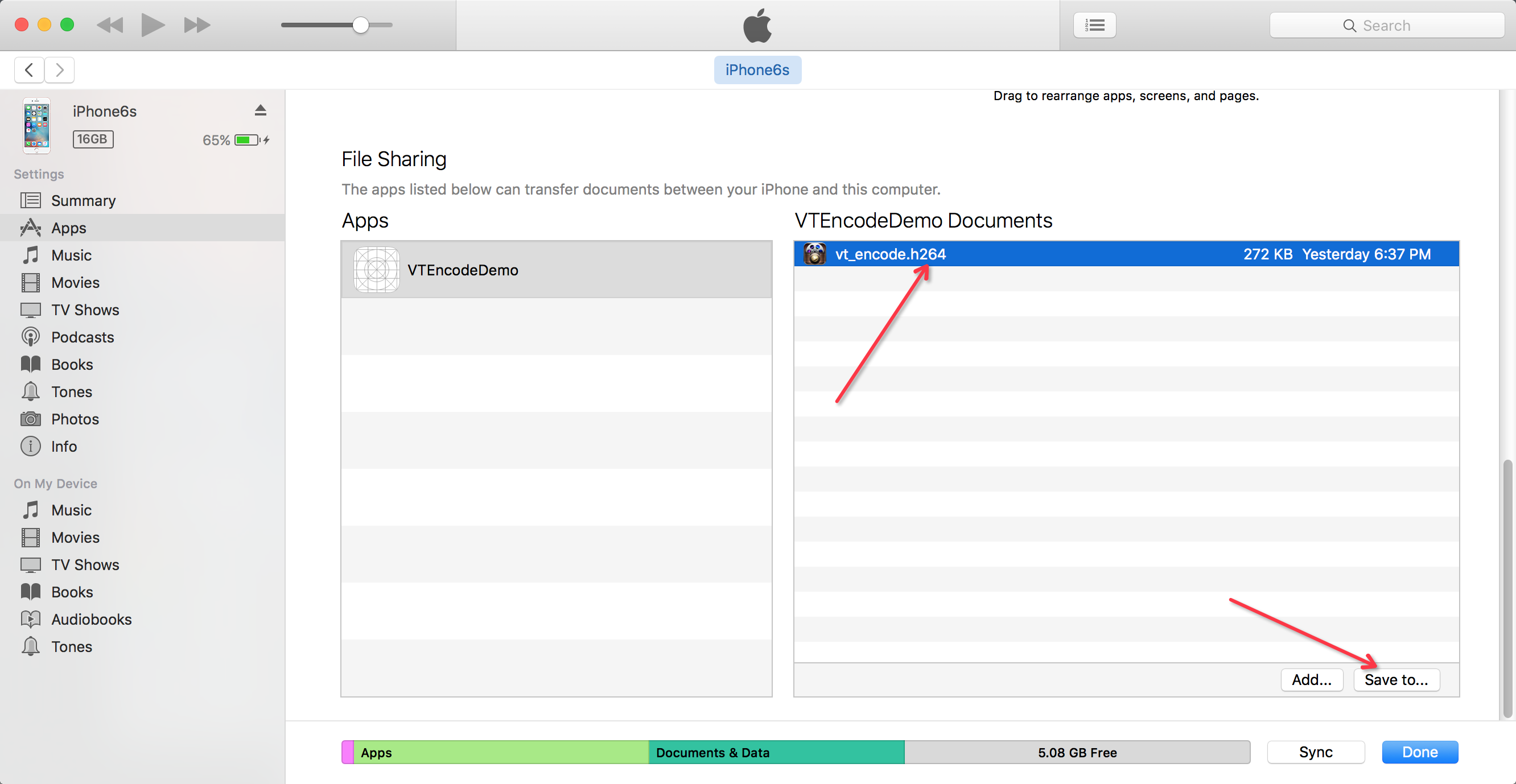如今各种直播如雨后春笋般在今年冒出来了,主要的移动平台Android和iOS都相继开放了视频硬件编解码接口,以往这些接口都是系统私有的,开发者无法使用。
视频编码解码是一项繁重的工作,尤其在移动平。所以从iOS8开始,苹果将VideoToolbox.framework开放了出来,使开发者可以使用iOS设备内置的硬件设备来进行视频的编码和解码工作。硬件编解码的好处是,复杂的计算由专门的硬件电路完成,往往比使用cpu计算更高效,速度更快,功耗也更低。
VideoToolbox 工作流程大致为:
- 创建Session ->设置编码相关参数 ->开始编码
- —> 循环输入源数据(yuv类型的数据,直接从摄像头获取)
- —> 获取编码后的h264数据
- 结束编码
以下为详细代码,内有详细注释,完整工程在文章末尾。
#pragma mark - videotoolbox methods
- (int)startEncodeSession:(int)width height:(int)height framerate:(int)fps bitrate:(int)bt
{
OSStatus status;
_frameCount = 0;
VTCompressionOutputCallback cb = encodeOutputCallback;
status = VTCompressionSessionCreate(kCFAllocatorDefault, width, height, kCMVideoCodecType_H264, NULL, NULL, NULL, cb, (__bridge void *)(self), &_encodeSesion);
if (status != noErr) {
NSLog(@"VTCompressionSessionCreate failed. ret=%d", (int)status);
return -1;
}
// 设置实时编码输出,降低编码延迟
status = VTSessionSetProperty(_encodeSesion, kVTCompressionPropertyKey_RealTime, kCFBooleanTrue);
NSLog(@"set realtime return: %d", (int)status);
// h264 profile, 直播一般使用baseline,可减少由于b帧带来的延时
status = VTSessionSetProperty(_encodeSesion, kVTCompressionPropertyKey_ProfileLevel, kVTProfileLevel_H264_Baseline_AutoLevel);
NSLog(@"set profile return: %d", (int)status);
// 设置编码码率(比特率),如果不设置,默认将会以很低的码率编码,导致编码出来的视频很模糊
status = VTSessionSetProperty(_encodeSesion, kVTCompressionPropertyKey_AverageBitRate, (__bridge CFTypeRef)@(bt)); // bps
status += VTSessionSetProperty(_encodeSesion, kVTCompressionPropertyKey_DataRateLimits, (__bridge CFArrayRef)@[@(bt*2/8), @1]); // Bps
NSLog(@"set bitrate return: %d", (int)status);
// 设置关键帧间隔,即gop size
status = VTSessionSetProperty(_encodeSesion, kVTCompressionPropertyKey_MaxKeyFrameInterval, (__bridge CFTypeRef)@(fps*2));
// 设置帧率,只用于初始化session,不是实际FPS
status = VTSessionSetProperty(_encodeSesion, kVTCompressionPropertyKey_ExpectedFrameRate, (__bridge CFTypeRef)@(fps));
NSLog(@"set framerate return: %d", (int)status);
// 开始编码
status = VTCompressionSessionPrepareToEncodeFrames(_encodeSesion);
NSLog(@"start encode return: %d", (int)status);
return 0;
}
// 编码一帧图像,使用queue,防止阻塞系统摄像头采集线程
- (void) encodeFrame:(CMSampleBufferRef )sampleBuffer
{
dispatch_sync(_encodeQueue, ^{
CVImageBufferRef imageBuffer = (CVImageBufferRef)CMSampleBufferGetImageBuffer(sampleBuffer);
// pts,必须设置,否则会导致编码出来的数据非常大,原因未知
CMTime pts = CMTimeMake(_frameCount, 1000);
CMTime duration = kCMTimeInvalid;
VTEncodeInfoFlags flags;
// 送入编码器编码
OSStatus statusCode = VTCompressionSessionEncodeFrame(_encodeSesion,
imageBuffer,
pts, duration,
NULL, NULL, &flags);
if (statusCode != noErr) {
NSLog(@"H264: VTCompressionSessionEncodeFrame failed with %d", (int)statusCode);
[self stopEncodeSession];
return;
}
});
}
- (void) stopEncodeSession
{
VTCompressionSessionCompleteFrames(_encodeSesion, kCMTimeInvalid);
VTCompressionSessionInvalidate(_encodeSesion);
CFRelease(_encodeSesion);
_encodeSesion = NULL;
}
// 编码回调,每当系统编码完一帧之后,会异步掉用该方法,此为c语言方法
void encodeOutputCallback(void *userData, void *sourceFrameRefCon, OSStatus status, VTEncodeInfoFlags infoFlags,
CMSampleBufferRef sampleBuffer )
{
if (status != noErr) {
NSLog(@"didCompressH264 error: with status %d, infoFlags %d", (int)status, (int)infoFlags);
return;
}
if (!CMSampleBufferDataIsReady(sampleBuffer))
{
NSLog(@"didCompressH264 data is not ready ");
return;
}
ViewController* vc = (__bridge ViewController*)userData;
// 判断当前帧是否为关键帧
bool keyframe = !CFDictionaryContainsKey( (CFArrayGetValueAtIndex(CMSampleBufferGetSampleAttachmentsArray(sampleBuffer, true), 0)), kCMSampleAttachmentKey_NotSync);
// 获取sps & pps数据. sps pps只需获取一次,保存在h264文件开头即可
if (keyframe && !vc->_spsppsFound)
{
size_t spsSize, spsCount;
size_t ppsSize, ppsCount;
const uint8_t *spsData, *ppsData;
CMFormatDescriptionRef formatDesc = CMSampleBufferGetFormatDescription(sampleBuffer);
OSStatus err0 = CMVideoFormatDescriptionGetH264ParameterSetAtIndex(formatDesc, 0, &spsData, &spsSize, &spsCount, 0 );
OSStatus err1 = CMVideoFormatDescriptionGetH264ParameterSetAtIndex(formatDesc, 1, &ppsData, &ppsSize, &ppsCount, 0 );
if (err0==noErr && err1==noErr)
{
vc->_spsppsFound = 1;
[vc writeH264Data:(void *)spsData length:spsSize addStartCode:YES];
[vc writeH264Data:(void *)ppsData length:ppsSize addStartCode:YES];
NSLog(@"got sps/pps data. Length: sps=%zu, pps=%zu", spsSize, ppsSize);
}
}
size_t lengthAtOffset, totalLength;
char *data;
CMBlockBufferRef dataBuffer = CMSampleBufferGetDataBuffer(sampleBuffer);
OSStatus error = CMBlockBufferGetDataPointer(dataBuffer, 0, &lengthAtOffset, &totalLength, &data);
if (error == noErr) {
size_t offset = 0;
const int lengthInfoSize = 4; // 返回的nalu数据前四个字节不是0001的startcode,而是大端模式的帧长度length
// 循环获取nalu数据
while (offset < totalLength - lengthInfoSize) {
uint32_t naluLength = 0;
memcpy(&naluLength, data + offset, lengthInfoSize); // 获取nalu的长度,
// 大端模式转化为系统端模式
naluLength = CFSwapInt32BigToHost(naluLength);
NSLog(@"got nalu data, length=%d, totalLength=%zu", naluLength, totalLength);
// 保存nalu数据到文件
[vc writeH264Data:data+offset+lengthInfoSize length:naluLength addStartCode:YES];
// 读取下一个nalu,一次回调可能包含多个nalu
offset += lengthInfoSize + naluLength;
}
}
}
// 保存h264数据到文件
- (void) writeH264Data:(void*)data length:(size_t)length addStartCode:(BOOL)b
{
// 添加4字节的 h264 协议 start code
const Byte bytes[] = "\x00\x00\x00\x01";
if (_h264File) {
if(b)
fwrite(bytes, 1, 4, _h264File);
fwrite(data, 1, length, _h264File);
} else {
NSLog(@"_h264File null error, check if it open successed");
}
}编码保存的h264数据保存到Document目录下,在Info.plist文件中添加Application supports iTunes file sharing ,并设置为YES,即可通过iTunes直接导出来,然后使用VLC播放器即可直接播放。
Demo 源码地址
WWDC关于VideoToolbox的视频: 百度云链接 密码: uzsr
==== 直播美颜相关问题,欢迎加群讨论:496010189 ====





























 被折叠的 条评论
为什么被折叠?
被折叠的 条评论
为什么被折叠?








